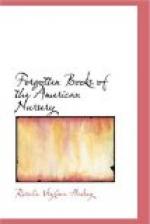But all this lady’s tales were not so lugubrious, and many were immense favorites. Children were even named for the hero of the “Little Millenium Boy.” Publishers frequently sent her orders for books to be “written to cuts,” and the “Busy Bee,” the “Errand Boy,” and the “Rose” were some of the results of this method of supplying the demand for her work. Naturally, Mrs. Sherwood, like Miss Edgeworth, had many imitators, but if we could believe the incidents related as true to life, parents would seem to have been either very indifferent to their children or forever suspicious of them. In Newbery’s time it had been thought no sin to wear fine buckled shoes, to be genteelly dressed with a wide “ribband;” but now the vain child was one who wore a white frock with pink sash, towards whom the finger of scorn was pointed, and from whom the moral was unfailingly drawn. Vanity was, apparently, an unpardonable sin, as when in a “Moral Tale,”
“Mamma observed the rising
lass
By stealth retiring to the
glass
To practise little arts unseen
In the true genius of thirteen.”
The constant effort to draw a lesson from every action sometimes led to overstepping the bounds of truth by the parents themselves, as for example in a similar instance of love for a mirror. “What is this I see, Harriet?” asked a mother in “Emulation.” “Is that the way you employ your precious time? I am no longer surprised at the alteration in your looks of late, that you have appeared so sickly, have lost your complexion; in short I have twenty times been on the point of asking you if you are ill. You look shockingly, child.”
“I am very well, Mamma, indeed,” cried Harriet, quite alarmed.
“Impossible, my dear, you can never look well, while you follow such an unwholesome practice. Looking-glasses were never intended for little girls, and very few sensible people use them as there is something really poisonous in their composition. To use them is not only prejudicial to the health but to the disposition.”
Although this conception of the use of looking-glasses as prejudicial to right living seems to hark back to the views expressed in the old story of the “Prodigal Daughter,” who sat before a mirror when the Devil made his second appearance, yet the world of story-book literature, even though its creators were sometimes either careless or ignorant of facts, now also emphasized the value of general knowledge, which it endeavored to pour in increasing quantity into the nursery. Miss More had started the stream of goody-goody books, while Miss Edgeworth, Mrs. Barbauld, and Thomas Day were the originators of the deluge of conversational bores, babies, boys, and teachers that threatened to flood the family book-shelves of America when the American writers for children came upon the scene.
FOOTNOTES:
[148-A] As long ago as seventeen hundred and sixty-two, Garrat Noel, a Dutch bookseller in New York, advertised that, “according to his Annual Custom, he ... provided a very large Assortment of Books ... as proper Presents at Christmas.” See page 68.




